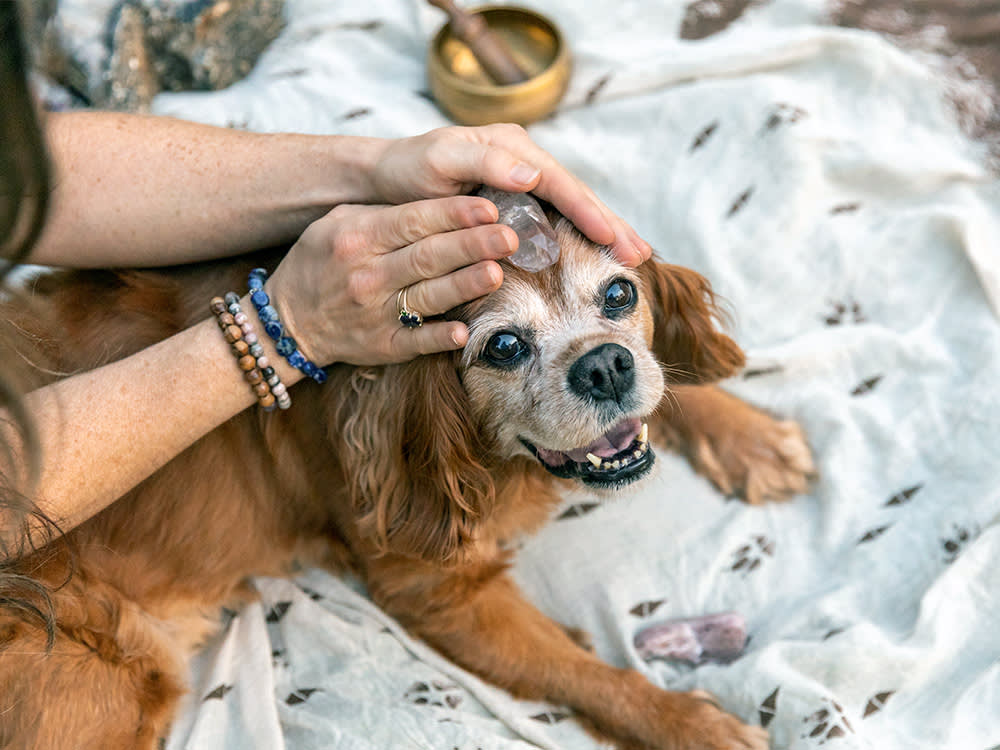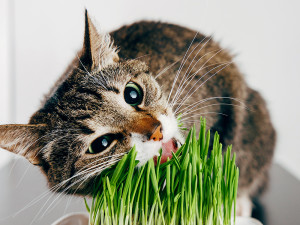6 Human Wellness Trends Making Their Way Into the Pet Space
Your pet can benefit from your self-care practices, from supplements to acupuncture

Share Article
I don’t mean to trigger budget-related stress (especially as you’re poring over your Q1 finances), but the wellness industry is expanding. No longer satisfied with infiltrating every aspect of human life – from the moment our clock wakes us with a gentle dawn simulation, to the moment we lay our head down to indulge in adaptogen-and-functional-mushroom-enhanced sleep – the concept of wellness is moving in on our pets.
Chances are you not only already know this but have participated in its growth. The pet supplementopens in new tab and fresh pet foodopens in new tab industries are flourishing, and formerly dismissed products are increasingly shown to be legitimate and worthwhile tools to help keep our pets healthy and happy. As the parent of a dog who takes both fish oil and an arthritis supplement (added to his dry food), I stand among the moisturised masses pushing the industry forwards.
This is becoming a trend for good reason
Dr Jill Elliotopens in new tab, a former homoeopathic veterinarian who now primarily treats humans, tells Kinship that she has indeed noticed an uptick in interest in more natural methods to decrease pain, increase health and prolong the life of our pets. “I’m finding people will come to me and say, ‘Hey, I’ve been using homoeopathy. Do you think it can help my pet?’” she says. “People are much more aware of all the alternative modalities now, and they’re more accepted. Then they say, ‘Oh, if it can help me, maybe it can help my pet, too.’”
Dr Joseph Wakshlagopens in new tab, a professor of clinical nutrition at the Cornell University College of Veterinary Medicine, has also seen a rise in the desire for pet wellness. “I think owners are looking for a gentler approach to treatment without pharmaceuticals due to the potential side effects,” he says. But he cautions that “it’s not necessarily always true that there are fewer side effects with natural products”, and that they may not be as effective as pharmaceuticals. “It’s a fine dance.”
It’s important to know what you’re buying – and who you’re buying from
Careful consumers know that products marketed under the ‘wellness’ label are not always what they claim. Jane Marie, host of The Dream podcastopens in new tab and author of the forthcoming book Selling the Dreamopens in new tab, has taken deep, critical dives into institutions (including the wellness industry) that attempt to sell consumers the promise of safety and happiness.
But, as the mother of a human child, she understands why the idea of purchasing wellness for a loved one is so alluring. “If there‘s a product or something out there that‘s going to help my daughter be healthier and happier, I’ll buy it,” says Jane.
At the same time, it’s hard to separate the idea of virtue signalling through consumerism – what she describes as “the capitalism of it all” – from the good intentions. “I think we all have the best of intentions,” says Jane. “I don’t think we‘re conscious of buying into that sort of virtue signalling.” But capitalism, she says, “feeds on these human frailties”.
An expert in spotting scams, Jane cautions against pet wellness companies that seem to be expanding rapidly. “I think we forget that in wellness, these brands don‘t have to go through any kind of rigorous testing or longitudinal studies,” she says, so rapid growth tends not to leave enough time to see that the product does what it claims.
She also recommends looking closely at anything that guarantees specific results, seems too good to be true, or markets itself on its exclusivity. “If a brand says, ‘we are the only people that have this thing’, that usually scares me. Because if they care about dogs, or humans, and it’s actually very helpful, why would they embargo it?” She points out that, of course, pharmaceutical companies do this all the time. “But we all agree that’s evil, right?”
With that said, let’s take a look at a few of the most popular (ideally non-evil) human wellness trends making their way into the pet space.
1. Supplements
A few years ago, my dog had surgery on an injured elbow. Afterwards, his surgeon suggested that he start taking a joint supplement, because his injury increased his chance of developing arthritis, already a risk in ageing dogs and cats. More recently, his vet added a clinically backed fish oil to his treatment plan, which he dutifully takes every day.
He’s one of a quickly growing groupopens in new tab of dogs and cats who take supplements both to minimise pain in the short term, and maintain health in the long term, just like their supplement-lovingopens in new tab humans. It’s a market predicted to be valued at $2.54 billion (£1.99 billion) in 2024opens in new tab, and nearly double in the following decade.
Dr Wakshlag says nutraceuticals, like fish oil and other joint supplements, “are certainly part of treatment for things like pain and mobility, and have their place”. But you have to be careful about which supplements you choose, as they’re not required to be approved by the Medicines and Healthcare products Regulatory Agency (MHRA) and vary – sometimes vastly – in quality.
“It’s really about finding things backed by clinical studies,” says Dr Wakshlag. “Unfortunately, there are hundreds of pet supplements claiming to have utility with no clinical science supporting their use.” Rather than take a risk on a supplement that might be bogus, or something that might interfere with medication your pet is currently taking, ask your vet to recommend something safe and clinically backed.
2. Acupuncture
Acupuncture, as you may know, is a form of alternative medicine that involves inserting thin needles into specific points on the body. This practice has its roots in traditional Chinese medicine, and its application to animalsopens in new tab aims to restore energy balance, enhance blood circulation, improve mobility, decrease pain and treat certain disorders.
“I was certified in acupuncture in 1993,” Dr Marcie Fallekopens in new tab, a holistic veterinarian and certified veterinary acupuncturist, tells Kinship. “I was one of only 500 in the world, and we were considered quacks. Now, it’s considered mainstream.” While popularised as a treatment option for humans, the practice is gaining traction in the pet space.
“Acupuncture does have mild effects on pain that can be useful,” says Dr Wakshlag. “However, each patient seems to respond differently, and many dogs and cats just don’t tolerate needles well.” Another concern is making sure in advance that your animal is healthy enough to receive the treatment.
“Have a medical doctor [vet] do an exam first, to tell you what‘s wrong,” says Dr Sara Winikoffopens in new tab, who provides both holistic and traditional veterinary therapies. “Because, for example, if your dog has a tumour, then acupuncture would not be my first choice.” In that case, says Dr Winikoff, you risk increasing blood flow to the tumour. “Sometimes, we think of these therapies, like acupuncture and homoeopathy and Chinese herbs, like, ‘Well, it can’t hurt.’ Well, guess what: it can hurt.”
On that point, Dr Wakshlag says to make sure you’re choosing an appropriately certified practitioner to provide a therapy like acupuncture. “I really think it’s important for owners to look towards veterinary specialists when they want to intervene,” he says, suggesting those with recognised board-certified specialties.
“It’s a hard area to navigate as an owner,” says Dr Wakshlag, and you shouldn’t take for granted that the person offering the service is necessarily the right person to trust with your pet’s health.
3. Mental enrichment
In recent years, pet parents have become increasingly curious about the inner life of their pets. Are they happy? Are they bored? Do they like their life? Do they like me? While these questions can easily take a person down a rabbit hole of self-doubt (Do they like my hair? Do they hate this outfit?), wondering whether our pets are under-stimulated marks a positive shift in the human-animal relationship.
Because of that curiosity, there has been a significant surge in the popularity of mental enrichment toys and activities for dogs and cats. This can mean a puzzle toy that simulates foraging for food for your cat, or a long, sniffy walk that allows your dog to use their powerful sense of smell. Mental-enrichment toys and experiences not only help prevent boredom but also contribute to a pet’s overall wellbeing by promoting cognitive development and reducing stress. Plus, it’s fun to watch your pet try to get treats out of a wobbly toy.
4. Personalised nutrition
You likely follow your own dietary rules – no gluten, perhaps, or Starbucks only when you really deserve a treat. Increasingly, our pets are getting on the personalised nutrition bandwagon. “The idea of personalised nutrition is growing, with more people wanting to feed human-grade foods, which is keeping board-certified veterinary nutritionists busy these days,” says Dr Wakshlag.
Indeed, tailoring nutrition to the specific needs of our pets is perhaps the fastest-growing trend in pet care. This approach involves considering factors like age, breed, size, health and activity levels to create customised meal plans, some of which can be shipped right to your door by a growing number of pet food companies.
Pet parents can choose from flash-frozen or dehydrated raw-food diets, to refrigerated human-grade options that look an awful lot like what we’d feed ourselves. Or they can consider adding superfoods to their pet’s standard food for a vitamin boost.
5. Skincare
Don’t worry, Drunk Elephant hasn‘t released a £100 pet vitamin-C day serum (not yet, anyway). But the pet skincare and coat-care market is booming, with pet parents spending $4.13 billionopens in new tab (£3.25 billion) globally on its products in 2022 and with a projected growth of almost 10 percent over the next decade.
Gone are the days of a one-size-fits-all pet shampoo, or – worse yet – using human shampoo in lieu of something animal specific (dog and cat skin is much thinner than human skin and has a different pH, making that move very inadvisable). Companies now offer a diverse range of shampoos and conditioners tailored to address specific skin concerns and accommodate various coat textures, often without using harsh chemicals.
Beyond shampoos and conditioners, you can find soothing skin creams, plant-based wipes, brushes, dry shampoos and detangling sprays; enough products to fill a day at the home pet spa. Just be careful the product you’re using isn’t doing more harm than good – look out for dry skin, excessive licking or scratching, redness or hair loss. And if anything seems concerning, make sure to ask your vet for guidance.
6. Wearable health-tracking technology
Like the fitness tracker that tells you, yet again, that you didn’t get a good night of sleep (thanks, I noticed), wearable tech has extended its reach to our pets. These devices, such as the health tracker Whistleopens in new tab, are designed to help us monitor our pets’ health and behaviour by tracking activities, monitoring vital signs and hopefully providing us with useful data that we can use to make better choices on their behalf.
Some can track, for example, whether a change in their diet increased or decreased their likelihood to scratch; others can track the quality of their sleep, or whether they’re getting an appropriate amount of exercise. Not available, yet, is a wearable monitor that tracks how much they love you and think you’re, actually, very funny – but fingers crossed that’s on its way.
Disclaimer alert: this article is here to share information and should not be taken as fact or medical advice. Always talk things over with your vet when making decisions, and use your best judgement.
References:

Kelly Conaboy
Kelly Conaboy is a writer and author whose work has been featured in New York Magazine, The New York Times, and The Atlantic. Her first book, The Particulars of Peter, is about her very particular dog, Peter. (Peter works primarily as a poet.)
Related articles
![Cat chewing on cat grass]()
8 Pet-Safe Plants Your Cat Can Veg Out On
Cats love the crunch of a houseplant. These ones will do them no harm
![Cat eating out of metal bowl]()
9 Foods You Should Never Feed Your Cat
Sharing isn’t always caring. Keep your cat safe by keeping these human snack staples to yourself
![Young woman playing with a dog outdoors stock photo.]()
Do Dogs Try and Make Us Laugh? The Internet Thinks So – Here’s What Science Says
If you think your pup’s basically James Acaster, science backs you up
![Black dog sitting on tiled floor]()
What’s Better Than a Tail Wag? A Circle Wag
Also called the ‘propeller wag’ or ‘helicopter tail’, this behaviour is a surefire way to tell that a dog is happy










